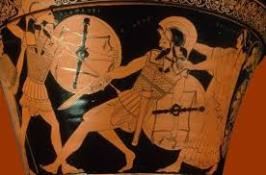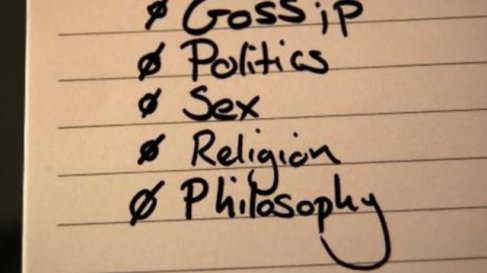 In his article published in Rhetoric Review, G. Mitchell Reyes discusses the variety of techniques used to persuade characters in Homer’s Iliad. Reyes, a doctoral candidate at Pennsylvania State University, claims that his essay will “ultimately assist contemporary rhetoricians in clarifying the qualities of persuasion…” (22-23). Reyes states that his goal is, “to draw the specific persuasive acts of the Iliad,” to create a broader understanding of what he calls “Homeric persuasion” for modern rhetoricians and readers (23). Reyes discusses four examples for such Homeric persuasion: honor, material, power, and justice. Reyes presents a valuable argument; however, the way in which he presents his information leaves much to be desired from his readers.
In his article published in Rhetoric Review, G. Mitchell Reyes discusses the variety of techniques used to persuade characters in Homer’s Iliad. Reyes, a doctoral candidate at Pennsylvania State University, claims that his essay will “ultimately assist contemporary rhetoricians in clarifying the qualities of persuasion…” (22-23). Reyes states that his goal is, “to draw the specific persuasive acts of the Iliad,” to create a broader understanding of what he calls “Homeric persuasion” for modern rhetoricians and readers (23). Reyes discusses four examples for such Homeric persuasion: honor, material, power, and justice. Reyes presents a valuable argument; however, the way in which he presents his information leaves much to be desired from his readers.
Reyes’s first example of Homeric persuasion is the use of honor. He states that there are two ways Homer’s characters can achieve this honorific ideal: “to be a doer of good deeds or to be a speaker of words” (23). Reyes immediately draws on textual evidence with an example of Achilles and Odysseus, stating that these two characters have no doubt mastered both deed and word in terms of honorific behavior. In contrast to Achilles and Odysseus, Reyes goes on to explain that most of the Homeric characters only harbor one of the two honorific ideals. As an example of the way in which a good speaker is revered, Reyes references one of Nestor’s early speeches. However, the reader never gets a good sense of the way Reyes believes Homer uses deeds alone to persuade characters with honor. As the essay continues, Reyes’s argument about honor begins to stray. He muddies the waters by suggesting that honor in the Iliad also comes from the character’s becoming enraged. He begins discussing the rationality, or rather, irrationality, of this rage on the heroic code. Just two pages into the essay, a modern reader gets bogged down in a variety of claims that do not seemed to tie into one another. Reyes continues discussing the ways in which the community in the epic is fragile, and suggests that “persuasion… tests the bonds of [this] community” (25). After this digression, however, Reyes does manage to come back to his original point of honor used as a means of persuasion, with many strong examples from a number of books in the epic. Reyes concludes that all of the characters in the epic want to be honored by the gods, fellow soldiers, and their families. He implies that the desire for honor persuades these characters to fight as they do. Although Reyes’s treatment of the first topic starts off strong, his argument for honor becomes relatively ineffective when clouded by irrelevant talk of bonds within the community.
As Reyes continues, he discusses the idea of material gain as a means of persuasion in the Iliad. Reyes states, “in fact, the first speech given has Chryses appealing to Agamemnon’s desire for material gain” (26). He goes on to quote the speech itself. As one of Reyes’s stronger points in the essay, the reader clearly understands that material gain is a major factor in persuading the characters to act in specific ways. Reyes mentions the specific use of females as material, as well as a means of gaining bountiful ransoms. Whether it be Chryses’ daughter who was bargained for with a kingly ransom, or Helen of Troy, the idea of gaining something, or someone rather, that one could show off was a major tactic employed throughout the epic. Reyes successfully reconnects to his first means of persuasion, by insinuating that there was something honorable about having material to parade in front of others.
Reyes broadens his argument by effectively explaining the connection between pity and material persuasion. The example of Lycaon’s relaying to Achilles how many oxen he is worth when begging for his life is used as an attempt to portray the similarity between pity and an appeal for material gain.
Reyes then introduces the source of persuasion as a powerful force—one in which each character in the Iliad ultimately seeks. Here, Reyes draws on examples from another scholar, Michael Naas, to support Homer’s appeal to power. As the essay moves forward, Reyes states, “the source of power, then, is not just the strength of an individual but the recognition and honor others give with obedience and material gifts” (28). This single sentence ties Reyes’s previous points of persuasion to his new claim, but here, Reyes becomes quite repetitive, and this redundancy becomes problematic for the reader.
In the same section entitled “Power,” Reyes introduces the topics of obedience, reconciliation, and unity. These claims lack definite information to support them, and they do not necessarily add any substance to the power argument. He makes a bold claim in stating that power drives each character in the epic because each wants to be powerful; however, comparatively, this section of Reyes’s essay is quite short and disjointed. Reyes’s thesis could have been much more interesting and effective had he expanded on the topic of power. This addition could ultimately have been much more influential to his readers. When thinking about a classic epic, power is at the forefront of many readers’ minds. After all, the majority of characters are gods. How could the idea of power as a means of persuasion have been so lightly glossed over by the author?
Nonetheless, Reyes’s final persuasion tactic draws on the idea of justice. He begins, “…justice is not the moral divide between right and wrong in the Iliad” (29). He argues instead that justice essentially means to follow the tradition that has been accepted by the community. Violation of this social and communal tradition is “the greatest social harm one can do” in the epic, according to Reyes (29). Reyes effectively makes use of textual evidence as a means of supporting his claims on the topic. Gods like Zeus are credited as the portrayers of this “justice” by enforcing the necessary punishment to those that violate ideals. Trust is assumed to go hand in hand with the Homeric idea of justice. For example, Reyes claims that Paris violates trust when taking Helen, thus, causing a breach in social justice. In turn, this breach of justice persuades armies to fight one another. Here, Reyes makes his most influential argument for persuasion. He is most direct in the way that he moves the reader through his thoughts on Homer’s use of justice. Readers find this section especially effective in understanding the idea of “Homeric persuasion.”
In his lengthy conclusion, Reyes restates his premise claiming, “Throughout my analysis I attempted to identify and distinguish certain sources of persuasion that transcend situational constraints… [and] how certain strategies of persuasion operate throughout the epic” (31). Reyes claims that none of the aforementioned examples work in isolation and draws on textual examples to support this claim. He quotes Henry Johnstone, Jr. as the man that proposed the thought-provoking question that fueled Reyes’s essay, ‘“Was persuasion in fact an ‘art’ in the Iliad” (32)? Reyes disappointingly answers that this is “still pending” (32).
Reyes did in fact attempt to distinguish between these sources of persuasion, however, ineffectively. As a reader, I was very disappointed in the pending status of the argument’s ending. What was the point of the essay if the ultimate question is left unanswered?
In this article published in Rhetoric Review, G. Mitchell Reyes discusses the variety of techniques used as methods of persuasion, or used to persuade, characters in the Iliad. Reyes attempts to discuss four examples of such Homeric persuasion: honor, material, power, and justice. Reyes ultimately leaves much to be desired in his essay. Although the use of textual evidence and outside sources increases the initial credibility of his argument, Reyes presents this argument in a befuddling manner. The way in which he attempts to add to his basic four ideals is perplexing, unclear, and appears off-topic. His argument would be substantially more effective if presented more clearly and concisely. Although Reyes’s ideas are thought-provoking, his delivery could be much more efficient.
Work Cited
Reyes, G. Mitchell. “Sources of Persuasion in the Iliad.” Rhetoric Review 21.1 (2002): 22-39. JSTOR. Web. 15 Feb. 2014.



